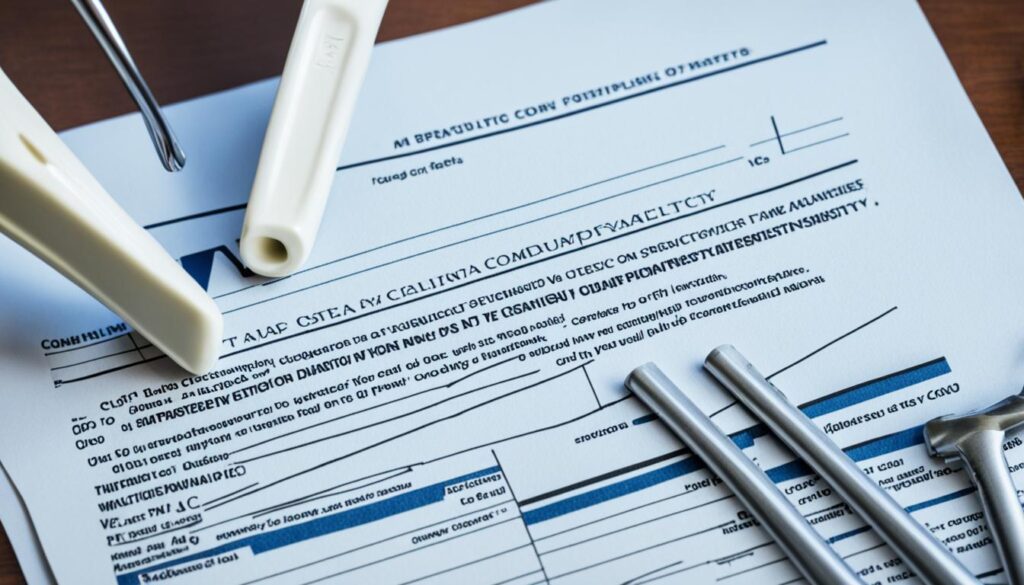Child Support and Alimony
VA Disability Garnishment for Alimony Explained

Did you know that VA disability benefits can be garnished to fulfill alimony payments for veterans who are divorced? This unexpected reality may not be common knowledge among many veterans. The legal position on VA disability garnishment for spousal support was clarified by the Federal Circuit’s decision in Rhone v. McDonough. Veterans who opt to convert a portion of their military retirement pay into disability compensation should be aware that the VA can withhold from their disability benefits for alimony and child support. The exact amount of garnishment varies, depending on factors such as the number of dependents the veteran is supporting.
Key Takeaways:
- VA disability compensation can be garnished to fulfill alimony obligations for veterans who have divorced.
- If a veteran has waived a portion of their military retirement pay to receive disability compensation, the VA can withhold disability compensation for alimony and child support payments.
- The amount that can be garnished depends on factors such as the number of dependents the veteran has.
Can VA Disability Compensation Be Used to Satisfy Alimony?
In the case of Rhone v. McDonough, the Federal Circuit addressed the issue of whether VA disability compensation can be used to satisfy alimony obligations. The court ruled that if a veteran has waived a portion of their military retirement pay to receive disability compensation, the VA can withhold disability compensation for alimony payments. This is authorized by 42 U.S.C. §659(a) and (h)(1)(A)(ii)(V). The amount that can be garnished will vary based on specific factors, such as the number of dependents the veteran has.
It is essential to note that Rhone v. McDonough clarified the legality of using VA disability compensation to satisfy alimony, providing clarity in cases where veterans have waived retirement pay for disability benefits. This allows state courts to order the garnishment of VA disability compensation to fulfill alimony obligations. The decision also establishes the legal basis for the VA’s authority to withhold disability compensation under such circumstances.
Example: Suppose a veteran has waived a portion of their military retirement pay in exchange for VA disability compensation. In that case, the state court can now order the VA to withhold disability compensation to satisfy alimony payments. The amount that can be garnished will vary depending on the specific circumstances, such as the number of dependents involved.

| Court Case | Issue Addressed | Ruling |
|---|---|---|
| Rhone v. McDonough | Utilization of VA disability compensation for alimony payment | VA can withhold disability compensation for alimony payments if the veteran has waived a portion of their military retirement pay |
“The court’s ruling in Rhone v. McDonough highlights the authority of state courts to order the garnishment of VA disability compensation for alimony obligations. This ensures that veterans who have waived retirement pay in exchange for disability benefits fulfill their financial responsibilities.”
The Rhone v. McDonough Case Summary
In the Rhone v. McDonough case, a veteran appealed the decision of the Court of Appeals for Veterans Claims affirming a decision of the Board of Veterans’ Appeals. The veteran had waived a portion of his military retirement pay to receive disability compensation. The court determined that the VA lawfully withheld a portion of his disability compensation payments to satisfy a state court order for alimony payments. This case, Vet. App. 20-2370, highlighted the authority of the VA, as granted by 42 U.S.C. §659(a) and (h)(1)(A)(ii)(V), to withhold disability compensation for alimony or child support payments when a veteran has waived a portion of their military retirement pay.
The Court of Appeals for Veterans Claims held that the VA had acted within its legal boundaries in withholding the disability compensation to fulfill the state court order. This decision sets a precedent for future cases involving garnishment of VA benefits for spousal support or child support obligations.
“The Court of Appeals for Veterans Claims found that the VA had the authority to withhold disability compensation for alimony or child support when a portion of the military retirement pay had been waived.”
This case emphasizes the importance of understanding the legal rights and obligations of veterans in relation to their VA disability benefits and support obligations. It also highlights the role of the Court of Appeals for Veterans Claims and the Board of Veterans’ Appeals in upholding or revising decisions regarding VA benefits.
Protection of VA Disability Benefits in Divorce
When going through a divorce, one of the concerns for disabled veterans is the potential loss of their VA disability benefits. However, there are legal provisions in place to protect these benefits and ensure they are not treated as marital property. Under the Uniformed Services Former Spouses’ Protection Act, VA disability benefits are exempt from being divided as part of a divorce settlement.
This means that disabled veterans can rest assured that their disability benefits will not be taken away or reduced due to the divorce. These benefits are intended to provide financial support and assistance to disabled veterans, and the law recognizes the importance of preserving and safeguarding them.
It’s important to note that while VA disability benefits are protected from being divided as marital property, they can still be considered when calculating child support payments. The court may take into account the veteran’s disability benefits as part of the overall financial resources when determining the appropriate amount of support.
To summarize, under the Uniformed Services Former Spouses’ Protection Act, VA disability benefits are safeguarded from being treated as marital property and divided in a divorce. This provides peace of mind to disabled veterans who may be concerned about the potential loss of their benefits during the divorce process.

Garnishment of VA Disability Benefits
Garnishment of VA benefits can occur in cases where a veteran fails to meet their spousal support or child support obligations. If a state court order is issued, the VA benefits can be garnished to ensure that the necessary payments are made. It’s important to note that this garnishment is applicable only if the veteran has waived a portion of their military retired pay to receive VA disability benefits.
The amount that can be garnished from the VA benefits will vary based on several factors. These include the veteran’s other sources of income and the needs of their former spouse and children. An assessment will be made to determine a reasonable amount that can be withheld for support payments.
Example case:
“In the case of Doe v. Smith, the state court ordered the garnishment of the veteran’s VA disability benefits to fulfill their spousal and child support obligations. The court considered the veteran’s other sources of income and the needs of the family members involved. As a result, 30% of the veteran’s VA benefits were garnished to meet the support payments.”
Garnishment of VA Benefits – Factors Considered
When determining the amount that can be garnished from VA benefits, various factors are taken into account:
- The veteran’s other sources of income
- The needs of the former spouse and children
- The overall financial situation of the veteran
- The specific state court order
By considering these factors, a reasonable and fair amount can be determined for garnishment. It is essential for the court to strike a balance that ensures support for the former spouse and children while also considering the financial circumstances of the veteran.
Garnishment Limits for VA Benefits
The percentage of VA benefits that can be garnished typically falls between 20% and 50%. This range allows for a reasonable portion of the benefits to be allocated towards spousal support and child support. A garnishment of less than 20% is generally considered insufficient to meet the support obligations, while a garnishment of more than 50% may cause undue hardship for the veteran.
Table: Maximum Percentage of Garnishment of VA Benefits
| Percentage Garnished | Garnishment Consideration |
|---|---|
| Less than 20% | Insufficient to meet support obligations |
| 20-50% | Fair allocation towards support payments |
| More than 50% | Potential undue hardship for the veteran |
Note: The actual percentage of garnishment may vary on a case-by-case basis, depending on the specific circumstances and court order.

How Much of VA Benefits Can Be Garnished?
The amount of VA benefits that can be reasonably garnished varies depending on several factors. The Department of Veterans Affairs (VA) assesses each case individually, taking into consideration the veteran’s financial situation, the needs of their dependents, and any special circumstances that may be present.
Generally, the VA allows for a reasonable garnishment of between 20% and 50% of VA benefits. However, amounts lower than 20% are considered insufficient to cover the necessary support obligations, while garnishing more than 50% is seen as causing undue financial hardship to the veteran.
When determining the specific percentage of benefits to be garnished, the VA considers the veteran’s other sources of income, such as employment earnings or retirement pensions. Additionally, the needs of the former spouse and children are taken into account, ensuring a fair allocation of support responsibilities.
It’s important to note that the VA aims to strike a balance between meeting the financial requirements of the recipient and the need to provide financial stability for the veteran. By considering these factors, the VA ensures that an appropriate amount of benefits is used to fulfill the necessary support obligations.

Circumstances Where Benefits Will Not Be Garnished
While VA benefits can be garnished for alimony or child support in certain situations, there are circumstances where garnishment is not permitted. These exemptions aim to protect veterans from undue financial hardship and consider specific details of the case. Here are the circumstances exempt from garnishment:
- Financial Hardship: Garnishment of VA benefits is not allowed if it would cause undue financial hardship for the veteran. This exemption ensures that veterans can maintain a certain standard of living and meet their essential needs.
- State Court Order: If a former spouse is living with another person and presenting themselves as married, garnishment of VA benefits is not permitted. This exemption recognizes the financial support provided by the new partner and avoids placing additional burdens on the veteran.
- Conjugal Infidelity: VA benefits cannot be garnished if the former spouse has been found guilty of conjugal infidelity. This exemption acknowledges the misconduct of the former spouse and protects the veteran from financial obligations resulting from their actions.
It’s important to note that when a child has been legally adopted, only partial garnishment may be permitted. This recognizes the responsibilities and financial contributions of both parents, ensuring a fair distribution of support.
| Exemption | Description |
|---|---|
| Financial Hardship | Garnishment is not allowed if it would cause undue financial hardship for the veteran. |
| State Court Order | Garnishment is not permitted if the former spouse is living with another person and presenting themselves as married. |
| Conjugal Infidelity | Benefits cannot be garnished if the former spouse has been found guilty of conjugal infidelity. |
| Child Adoption | If a child has been legally adopted, only partial garnishment may be permitted. |

Apportionment of VA Benefits
Apportionment plays a crucial role in ensuring that the families of veterans receive the necessary support from VA benefits. It involves assigning a portion of a veteran’s disability benefits to a family member. To initiate the apportionment process, the family member must file VA Form 21-0788, Information Regarding Apportionment of Beneficiary’s Award. This step is essential before any garnishment for spousal or child support can occur.
The VA will determine the amount of apportionment based on various factors, including the number of dependents and the financial needs of the family member. This ensures a fair and equitable distribution of benefits that aligns with the veteran’s family obligations. By implementing apportionment, the VA aims to support the financial well-being of the veteran’s family.
Apportionment of VA benefits is a legal process designed to provide valuable assistance to eligible family members, assisting them in meeting their financial needs. It offers financial stability and security during challenging times. By utilizing apportionment, the VA demonstrates its commitment to promoting the well-being of veterans and their families.

Consideration of VA Income
Even if VA benefits cannot be garnished, the court may still consider the veteran’s VA income when calculating child support or alimony. If the VA disability benefits make up a significant portion of the veteran’s total income, they may be used to fulfill support obligations. It’s important to consult with a VA disability lawyer for legal assistance in protecting VA disability benefits or establishing a fair amount of support.
Apportionment in Case of Incarceration
Spouses of incarcerated veterans may file for apportionment of the veteran’s benefits. This allows the full amount of the disability compensation to be paid to the spouse instead of the reduced amount that the incarcerated veteran receives. This can help provide financial support for the spouse while the veteran is incarcerated.
If a veteran is serving time in prison, their disability compensation may be reduced or suspended. This reduction in benefits can have a significant impact on the financial well-being of the veteran’s spouse or dependent. To address this issue, the spouse can file for apportionment of the veteran’s benefits to ensure they receive the full amount of compensation.
Apportionment is a legal process through which the VA can redirect a portion or all of a veteran’s benefits to their spouse or dependent. It allows the spouse to access the full amount of VA benefits that the incarcerated veteran would otherwise receive. This provides much-needed financial support for the spouse and helps mitigate the financial strain caused by the reduced disability compensation.
It’s important to note that apportionment is subject to certain eligibility criteria and requirements. The spouse will need to provide documentation and evidence of the need for apportionment, such as proof of financial dependency and the veteran’s incarceration status. Consulting with a qualified VA benefits attorney can help streamline the apportionment process and ensure that the spouse receives the full benefits they are entitled to.
In summary, apportionment of VA benefits in the case of an incarcerated veteran allows the spouse to receive the full amount of disability compensation, providing necessary financial support during the veteran’s incarceration. This process helps alleviate the burden of reduced benefits and ensures that the spouse has the means to meet their financial obligations and maintain a stable livelihood.
Conclusion
In conclusion, VA disability benefits can be subject to garnishment for alimony and child support under specific circumstances. The exact amount that can be garnished depends on factors such as the veteran’s military retired pay status and the number of dependents they have. However, it is important to note that VA disability benefits are generally protected from being divided as marital property during a divorce. This legal protection ensures that disabled veterans can maintain their financial stability and access to the benefits they are entitled to.
If you are a veteran dealing with spousal support obligations or facing the garnishment of your VA disability benefits, it is crucial to seek the guidance of a VA disability lawyer. They can provide you with valuable advice on how to protect your benefits and understand your rights in relation to alimony and child support. By working with an experienced attorney, you can navigate the complexities of the legal system and ensure that you receive the appropriate legal protections.
Remember, securing the services of a knowledgeable VA disability lawyer can make a significant difference in safeguarding your VA disability benefits while fulfilling your financial obligations. Whether you need assistance with understanding your legal protections or negotiating the terms of your support payments, a lawyer specializing in VA disability law can offer you the necessary expertise and support to navigate these challenging circumstances successfully.
Yes, under certain circumstances. If a veteran has waived a portion of their military retirement pay to receive disability compensation, the VA can withhold disability compensation for alimony and child support payments. The exact amount that can be garnished depends on various factors, such as the number of dependents the veteran has. In the case of Rhone v. McDonough, the Federal Circuit confirmed that the VA can withhold disability compensation for alimony payments if a veteran has waived a portion of their military retirement pay to receive disability compensation.
Under the Uniformed Services Former Spouses’ Protection Act, VA disability benefits are exempt from being treated as marital property and cannot be divided as part of a divorce. However, VA disability benefits can still be considered when calculating child support payments.
Yes, if a veteran has waived a portion of their military retired pay to receive VA disability benefits, the state can order their VA benefits to be garnished for alimony or child support payments.
The amount of VA benefits that can be garnished will vary based on factors such as the veteran’s other sources of income and the needs of their former spouse and children. Generally, between 20% and 50% of VA benefits can be garnished.
Garnishment is not permitted if it would cause undue financial hardship for the veteran. Additionally, benefits cannot be garnished if the former spouse is living with another person and presenting themselves as married or if the former spouse has been found guilty of conjugal infidelity. Apportionment refers to the process of assigning a portion of a veteran’s disability benefits to a family member. This is necessary before garnishment for spousal or child support can occur and aims to ensure that the veteran’s family receives support from the VA benefits.
Even if VA benefits cannot be garnished, the court may still consider the veteran’s VA income when calculating child support or alimony if it makes up a significant portion of their total income.
Yes, the spouse of an incarcerated veteran may file for apportionment of the full amount of the disability compensation, allowing them to receive the full benefits instead of the reduced amount that the incarcerated veteran receives.
It is important for veterans to consult with a VA disability lawyer for legal assistance in protecting their VA disability benefits or establishing a fair amount of support, considering their rights and legal protections in relation to spousal support obligations.
FAQ
Can VA disability compensation be garnished to fulfill alimony obligations?
What was the outcome of the Rhone v. McDonough case?
What is the Uniformed Services Former Spouses’ Protection Act?
Can VA disability benefits be garnished for spousal or child support?
How much of VA benefits can be garnished?
Are there circumstances where VA benefits cannot be garnished?
What is apportionment of VA benefits?
Can VA income be considered when calculating child support or alimony?
Can the spouse of an incarcerated veteran file for apportionment of VA benefits?
How can veterans protect their VA disability benefits in divorce?
Understanding the financial implications of divorce can be daunting. Christopher, our Financial Strategist, makes it accessible and manageable. He offers strategic insights into financial planning, asset division, and budgeting during and after divorce. Christopher’s guidance is invaluable for anyone looking to navigate the financial challenges of divorce with confidence and clarity.
Child Support and Alimony
Alimony in Virginia for Stay at Home Mom Insights

Did you know that in Virginia, alimony, also known as spousal support, can be awarded to stay-at-home mothers after a divorce?
For many stay-at-home moms, divorce can be an especially challenging time as they navigate post-divorce financial stability. Spousal support plays a crucial role in providing a fresh start and the opportunity to become financially independent. Understanding the factors considered by Virginia courts when determining spousal support eligibility is crucial.
Stay tuned to learn more about the challenges stay-at-home moms face, the factors taken into account when determining spousal support in Virginia, and how to plan for financial independence during and after a divorce.
Key Takeaways:
- Spousal support, also known as alimony, can be awarded to stay-at-home moms in Virginia.
- Virginia courts consider factors such as education, work experience, and the length of the marriage when determining spousal support eligibility.
- Stay-at-home moms should consider financial planning, returning to work, and working with professionals during the divorce process.
- Divorce mediation can be a valuable option for amicably resolving financial matters.
- Child custody and support are important considerations for stay-at-home moms.
The Challenges of Being a Stay-at-Home Mom
Stay-at-home spouses, typically moms, often sacrifice their careers to take care of their children. This can result in financial dependence on the other spouse, making the divorce process challenging for stay-at-home moms. Concerns about future financial security, returning to the workforce, and adjusting to new circumstances are common for stay-at-home moms going through divorce. Spousal support can play a crucial role in providing them with a fresh start and the opportunity to become financially independent.
Being a stay-at-home mom can be an incredibly rewarding role, but it also comes with its challenges. Many moms choose to leave their careers temporarily to prioritize their children’s upbringing and well-being. While this decision may be fulfilling in many ways, it can lead to financial dependence on the other spouse.
The issue of financial dependence can become especially challenging during the divorce process. Stay-at-home moms may find themselves without a steady income and worried about their future financial security. They may have concerns about how they will support themselves and their children, as well as the potential difficulties of reentering the workforce after an extended hiatus.
One possible solution for stay-at-home moms facing these challenges is spousal support, also known as alimony. Spousal support is a court-ordered payment from one spouse to the other to help maintain a reasonable standard of living after divorce. It is intended to provide the stay-at-home spouse with the financial means to transition into independence.
Future Financial Security is a Priority
When going through a divorce, stay-at-home moms understandably worry about their future financial security. They may have relied on their spouse’s income and assets throughout the marriage and now find themselves uncertain about how to support themselves and their children.
Spousal support can provide a lifeline for stay-at-home moms, allowing them to secure their financial future as they adjust to the challenges of divorce. With the help of spousal support, stay-at-home moms can focus on rebuilding their lives, exploring career opportunities, and ensuring their well-being and the well-being of their children.
Spousal support gives stay-at-home moms the peace of mind they need to navigate the divorce process and plan for a stable future.
Returning to the Workforce
For many stay-at-home moms, returning to the workforce can be a daunting prospect. They may worry about gaps in their resume, outdated skills, and the lack of recent work experience. Additionally, they may face challenges balancing work and family responsibilities.
However, with the support provided by spousal support, stay-at-home moms can explore options for returning to work with greater confidence. They can pursue additional education or training, update their skills, and network with professionals in their desired field. Spousal support can ease the financial burden and allow stay-at-home moms to focus on building a successful career while still being there for their children.
Overcoming Adjustment Challenges
Divorce brings significant changes and adjustments for everyone involved, including stay-at-home moms. They may have to adapt to a new living situation, potential changes in custody arrangements, and the emotional impact of the divorce itself.
Spousal support can provide the necessary financial stability to help stay-at-home moms navigate these challenges. It can alleviate some of the stress and uncertainty associated with the transition and allow them to prioritize their well-being and the well-being of their children.

| Challenges of Being a Stay-at-Home Mom | Solutions |
|---|---|
| Financial dependence on the other spouse | Spousal support provides financial assistance to achieve independence |
| Concerns about future financial security | Spousal support ensures stability and peace of mind |
| Difficulties of returning to the workforce | Spousal support helps with the financial aspects of career reentry |
| Adjusting to new circumstances | Spousal support eases the transition process and provides stability |
Factors Considered in Determining Spousal Support in Virginia
In Virginia, the determination of spousal support is a multifaceted process that takes into account several statutory factors outlined in the Virginia Code. These factors are crucial in assessing the needs and financial resources of each spouse, ensuring an equitable resolution. Understanding how these factors apply to your specific situation is essential for stay-at-home moms seeking spousal support.
The Virginia Code considers the following factors when determining spousal support:
- Obligations, needs, and financial resources of each party
- Standard of living established during the marriage
- Duration of the marriage
- Age and physical condition of the parties
- Contributions of each party to the well-being of the family
Additionally, the court evaluates other factors such as property interests, earning capacity, education and training, as well as decisions made during the marriage. These factors collectively shape the court’s decision regarding the amount and duration of spousal support.
Understanding the statutory factors involved in spousal support determinations can empower stay-at-home moms to effectively navigate the legal process and secure the financial assistance they deserve.

Image: Spousal support is determined based on various factors in Virginia.
Assessing the Amount of Spousal Support in Virginia
In Virginia, the amount of spousal support is determined through a comparative income and needs-based analysis. Both parties’ monthly expenses and incomes are considered, along with the ability to support two households. There is no specific calculation for determining the amount of spousal support, as each case is determined based on its individual facts. Factors such as the financial needs of the stay-at-home spouse, the length of time needed to become financially independent, and the lifestyle established during the marriage are taken into account.
During the spousal support assessment, the court examines the income of both spouses and considers their financial obligations. It takes into account the standard of living established during the marriage, as well as the length of the marriage itself. The court also evaluates the age and physical condition of each party and considers their contributions to the family’s well-being.
The court may analyze the earning capacity of both parties, their education and training, and any decisions made during the marriage that may have affected their financial situation. Additionally, property interests are reviewed, along with any other relevant individual facts. This comprehensive evaluation allows the court to determine a fair and equitable amount of spousal support that considers the unique circumstances of the case.
“The amount of spousal support can vary significantly from case to case, depending on the individual facts and circumstances involved. It is crucial for stay-at-home spouses to provide all necessary financial information to ensure a fair assessment of their needs and capabilities.”
Ultimately, the goal of assessing the amount of spousal support is to provide the stay-at-home spouse with the necessary financial assistance to maintain a similar standard of living post-divorce. It takes into account the individual needs and abilities of both parties, aiming to strike a balance between providing support and encouraging self-sufficiency. This analysis helps ensure a fair outcome that promotes the well-being and financial stability of the stay-at-home spouse.

Planning for Financial Independence as a Stay-at-Home Mom
During and after divorce, it is crucial for stay-at-home moms to consider their options for financial independence. This involves creating a comprehensive plan that encompasses various aspects such as career development, education or training, and exploring job opportunities.
Developing a career plan is essential for stay-at-home moms seeking financial independence. By identifying their interests, skills, and market demand, they can confidently navigate the job market and secure employment that aligns with their goals. Gaining additional education or training can also enhance their qualifications and increase their chances of success in their chosen field.
“Having a well-thought-out career plan helps stay-at-home moms confidently transition back into the workforce and build a stable financial future.” – Sarah Johnson
Creating budgets for different scenarios is another crucial aspect of financial planning for stay-at-home moms. By carefully assessing their current financial situation and considering potential changes in income and expenses, they can develop a roadmap for managing their finances effectively. Understanding credit and its impact on financial stability is also important, as it allows stay-at-home moms to make informed decisions and build a positive credit history.
Organizing financial documents is an essential step for stay-at-home moms planning for financial independence. By gathering and organizing important documents such as bank statements, tax returns, and investment records, they can gain a clear understanding of their financial picture and make informed decisions about their future.
It is crucial for stay-at-home moms to work with a trusted attorney who specializes in divorce and family law. A knowledgeable attorney can provide valuable guidance on financial matters, advocate for their best interests during negotiations, and ensure that all legal aspects of the divorce process are handled effectively.

The Importance of Divorce Mediation
Divorce mediation can be a valuable option for stay-at-home moms. Mediation allows both parties to negotiate and reach a fair settlement that takes into account the needs of the stay-at-home mom and the children. It is important to be transparent and honest during mediation, discussing financial concerns and future employment plans.
While mediation may not be suitable for every case, it can provide an opportunity for amicable resolution and minimize legal costs.

Considerations for Child Custody and Support
Child custody and support are crucial aspects to consider when going through a divorce as a stay-at-home mom. In Virginia, the courts prioritize the best interests of the child when making custody decisions, ensuring their well-being remains the top priority.
As a stay-at-home mom, you may be concerned about your ability to provide for your children after the divorce. Seeking temporary or permanent spousal support can help ensure you have the financial means to continue caring for your children.
Factors Influencing Custody and Support Determinations
Understanding the factors that influence custody and support determinations is essential for stay-at-home moms navigating the divorce process. Here are some key considerations:
- The child’s age, physical and emotional needs.
- The parents’ ability to meet the child’s needs, including their work schedules and capacity to care for the child.
- The child’s relationship with each parent and the willingness of each parent to encourage a healthy relationship with the other.
- The child’s current living situation, school, and community involvement.
- The parents’ mental and physical health.
These are just a few examples of the factors that courts take into account when determining child custody and support arrangements. It is crucial to work with an experienced attorney who can guide you through this process and advocate for your rights as a stay-at-home mom.

| Child Custody | Child Support |
|---|---|
| Decisions regarding legal and physical custody of the child. | Financial support provided by the non-custodial parent to the custodial parent for the child’s upbringing. |
| Joint custody, sole custody, or visitation rights for the non-custodial parent. | Calculation of child support based on the parents’ incomes and the child’s needs. |
| The child’s best interests and their relationship with each parent are considered. | The child support guidelines in Virginia are used to determine the appropriate amount. |
Remember, the well-being of your children is the primary focus when determining child custody and support arrangements. By understanding the factors involved and having the right support, you can navigate this part of the divorce process with confidence.
Securing Your Financial Future
During the divorce process, it is essential for stay-at-home moms to take proactive steps to secure their financial future. This involves various considerations, including gathering financial documents, assessing property division, managing debt, and planning for future financial stability.
Gathering financial documents is a crucial first step in understanding the full picture of your financial situation. It is recommended to collect bank statements, tax returns, investment account statements, and any other relevant financial records. These documents will not only provide a comprehensive overview but can also serve as evidence during property division negotiations.
Understanding property division is vital in protecting your financial interests. Marital property, including assets and debts acquired during the marriage, will be divided between you and your spouse. It is essential to have an up-to-date valuation of all marital assets, such as real estate, vehicles, retirement accounts, and business interests. This valuation can help ensure a fair distribution of property.
Debt is another important consideration when securing your financial future. Assessing both joint and individual debt is crucial to determining your financial obligations. It is recommended to create a comprehensive list of all outstanding debts, including credit cards, loans, and mortgages. Understanding your debt situation can guide you in negotiating a fair division of liabilities and managing your financial responsibilities effectively.
Creating a budget is a key component in determining your future financial needs. Consider your current and anticipated expenses, including housing costs, utilities, healthcare, and childcare. By analyzing your income, expenses, and potential future employment opportunities, you can develop a budget that aligns with your financial goals and aspirations.
Working with a divorce attorney who specializes in family law can provide valuable guidance and support throughout the process. An experienced attorney can help you navigate the complex financial aspects of divorce, advocate for your best interests, and ensure a fair settlement.
Table: Financial Documents Checklist
| Financial Documents | Description |
|---|---|
| Bank statements | Statements from all bank accounts, including checking, savings, and investment accounts |
| Tax returns | Recent tax returns, including W-2 forms and supporting documents |
| Retirement account statements | Statements from 401(k), IRA, or other retirement accounts |
| Real estate documents | Deeds, mortgage statements, and related paperwork for any owned properties |
| Vehicle documents | Title and loan information for any vehicles owned |
| Business documents | Records related to any business interests, partnerships, or sole proprietorships |
By taking these steps, stay-at-home moms can work towards securing their financial future and ensuring a solid foundation of financial security.

Exploring Spousal Support in Virginia
When it comes to divorce cases involving stay-at-home moms, spousal support, also known as alimony, continues to be a significant factor. Virginia law recognizes the valuable financial contributions made by stay-at-home spouses and seeks to ensure their well-being even after a divorce. However, the availability and duration of spousal support are determined by considering various factors, including the income, resources, needs, and financial obligations of each spouse.
The court takes into account several additional factors when determining spousal support in Virginia. These factors include the standard of living established during the marriage, the age and health of the spouses, and the length of the marriage. By examining these factors, the court aims to create a fair and equitable arrangement that reflects both parties’ financial contributions and needs.
A key consideration in spousal support cases is the standard of living established during the marriage. The court recognizes that the stay-at-home spouse’s financial contributions may have allowed the family to enjoy a certain quality of life. Therefore, it strives to provide spousal support that allows the recipient to maintain a similar standard of living even after the divorce.
The court also considers the age and health of the spouses when determining spousal support. If the stay-at-home spouse is older or has health issues that limit their ability to work or reenter the workforce, it may factor into a higher spousal support award. This recognition aims to ensure that the stay-at-home spouse can meet their financial needs even without the support of the other spouse.
Lastly, the length of the marriage plays a role in determining spousal support. In longer marriages, the court may award spousal support for a more extended period, recognizing that the stay-at-home spouse has dedicated a significant portion of their life to supporting the marriage and raising a family.
Overall, spousal support in Virginia aims to acknowledge the financial contributions of stay-at-home spouses and provide them with the necessary financial support to transition into post-divorce life. By understanding the relevant factors and seeking professional guidance, stay-at-home moms can navigate the complexities of spousal support and secure a fair outcome.

Factors Considered in Determining Spousal Support
| Factors | Description |
|---|---|
| Income and Resources | The financial capacity and assets of each spouse. |
| Needs and Financial Obligations | The financial requirements and obligations of each spouse. |
| Standard of Living | The lifestyle established during the marriage. |
| Age and Health | The age and physical condition of the spouses. |
| Length of the Marriage | The duration of the marriage. |
Conclusion
Going through a divorce as a stay-at-home mom can be challenging, but with proper financial planning and support, it is possible to achieve financial stability. Understanding the factors involved in determining spousal support, exploring options for returning to work, and working with professionals such as divorce attorneys and mediators can help stay-at-home moms navigate the divorce process and secure their financial future. By taking proactive steps and making informed decisions, stay-at-home moms can move forward with confidence.
Virginia courts consider several factors when determining spousal support eligibility, including the obligations, needs, and financial resources of each party, the standard of living established during the marriage, the duration of the marriage, the age and physical condition of the parties, and the contributions of each party to the well-being of the family. Other factors taken into account include property interests, earning capacity, education and training, and decisions made during the marriage.
In Virginia, the amount of spousal support is determined through a comparative income and needs-based analysis. Both parties’ monthly expenses and incomes are considered, along with the ability to support two households. There is no specific calculation for determining the amount of spousal support, as each case is determined based on its individual facts. Factors such as the financial needs of the stay-at-home spouse, the length of time needed to become financially independent, and the lifestyle established during the marriage are taken into account.
Stay-at-home moms can take steps such as gathering financial documents, getting an up-to-date valuation of marital property, understanding credit options, creating budgets, and considering future employment plans. It is also important for them to work with a divorce attorney and consider divorce mediation to receive guidance and support throughout the process.
Spousal support, also known as alimony, can play a crucial role in providing stay-at-home moms with financial security and the opportunity to become financially independent. It can help them transition to a new chapter of their lives by providing necessary support during and after divorce. Divorce mediation allows stay-at-home moms and their spouses to negotiate and reach a fair settlement that considers the needs of the stay-at-home mom and the children. It can provide an opportunity for amicable resolution and can help minimize legal costs.
Courts in Virginia prioritize the best interests of the child when making custody decisions. Stay-at-home moms may seek temporary or permanent spousal support to ensure they can continue providing for their children. Understanding the factors that influence custody and support determinations is important for stay-at-home moms going through divorce.
The Virginia law recognizes the contributions made by stay-at-home spouses to the well-being of the family. Spousal support, or alimony, is still a factor in many divorce cases involving stay-at-home moms. However, the availability and duration of spousal support depend on various factors, such as income, resources, needs, and financial obligations of each spouse.
Stay-at-home moms can achieve financial stability post-divorce by understanding the factors involved in determining spousal support, exploring options for returning to work, and working with professionals such as divorce attorneys and mediators. Taking proactive steps, making informed decisions, and planning for the future can help stay-at-home moms secure their financial future.
FAQ
What factors are considered in determining spousal support in Virginia?
How is the amount of spousal support determined in Virginia?
What steps can stay-at-home moms take to secure their financial future during divorce?
What role does spousal support play in the divorce process for stay-at-home moms?
How can divorce mediation benefit stay-at-home moms?
What considerations should stay-at-home moms keep in mind regarding child custody and support?
How does the Virginia law recognize the contributions of stay-at-home spouses?
What can stay-at-home moms do to achieve financial stability post-divorce?
Understanding the financial implications of divorce can be daunting. Christopher, our Financial Strategist, makes it accessible and manageable. He offers strategic insights into financial planning, asset division, and budgeting during and after divorce. Christopher’s guidance is invaluable for anyone looking to navigate the financial challenges of divorce with confidence and clarity.
Child Support and Alimony
Understanding New York State Alimony Laws

Did you know that in New York, there are specific laws in place concerning alimony, which govern financial assistance to a spouse both during and after a divorce? Also referred to as spousal support or maintenance, this aspect is crucial in New York divorce cases, with the goal of ensuring fairness and financial stability for the spouse who relies on the other financially. Understanding these rules is important for individuals going through a divorce or seeking information about alimony in New York.
Key Takeaways:
- New York state alimony, also called spousal support or spousal maintenance, is a payment made by one spouse to the other during and after divorce proceedings.
- There are two types of alimony in New York: temporary maintenance awarded during the divorce process and post-divorce maintenance awarded after the divorce is finalized.
- The amount and duration of alimony payments are determined based on various factors, including the length of the marriage, the income of both spouses, the standard of living during the marriage, and the health and earning capacity of each spouse.
- Consulting an experienced attorney is highly recommended to navigate the complexities of New York State alimony laws.
- Understanding the types of alimony, calculations involved, and the factors considered by the courts can provide clarity and help make informed decisions.
Types of Alimony in New York
When it comes to alimony in New York, there are two main types: temporary maintenance and post-divorce maintenance. Each type serves a different purpose and is awarded based on specific criteria.
Temporary Maintenance
Temporary maintenance, also known as pendente lite maintenance, is awarded during the divorce process. It is designed to provide financial support to the lesser-earning spouse until the divorce is finalized. Temporary maintenance helps ensure that both parties have the resources they need to cover their living expenses during this transitional period.
Post-Divorce Maintenance
Post-divorce maintenance, on the other hand, is awarded after the divorce is finalized. This type of alimony is intended to provide ongoing financial support to the lesser-earning spouse, helping them maintain a similar standard of living as they did during the marriage. The amount and duration of post-divorce maintenance in New York can vary depending on factors such as the length of the marriage and the incomes of both spouses.
It’s important to note that it is possible to receive both temporary maintenance and post-divorce maintenance in New York, as they serve different purposes and are determined separately.

| Criteria | Temporary Maintenance | Post-Divorce Maintenance |
|---|---|---|
| Purpose | To provide financial support during the divorce process | To provide ongoing financial support after the divorce is finalized |
| Timeframe | Ends when the final divorce decree is made | Paid for a specified duration based on the court’s determination |
| Criteria | Based on the financial needs of the lesser-earning spouse during the divorce | Based on factors such as the length of the marriage and the incomes of both spouses |
| Modification | Can be modified during the divorce process | May be modified if there is a significant change in circumstances |
Understanding the different types of alimony in New York is essential for navigating the divorce process. By consulting with an experienced attorney, you can obtain the guidance and support needed to ensure your financial interests are protected.
Calculating Temporary Maintenance in New York
Temporary maintenance, also known as pendente lite maintenance, is an important aspect of divorce proceedings in New York. Determining the amount of temporary maintenance involves a statutory formula that takes into account several factors, including the incomes of both spouses.
The formula for calculating temporary maintenance in New York is straightforward. The paying spouse’s income is considered up to a maximum of $203,000. Any income above that threshold may still be taken into account at the court’s discretion.
The court follows specific guidelines when calculating temporary maintenance awards, but it can deviate from the guidelines if it deems the calculated amount to be unjust or inappropriate based on the individual circumstances of the case.
| Factors Considered for Calculating Temporary Maintenance |
|---|
| Income of both spouses |
| Maximum income threshold of $203,000 |
| Court’s discretion to deviate from guidelines |
Once the temporary maintenance amount is determined, it is important to note that these payments will cease once the divorce is finalized or if one of the spouses passes away.

Calculating Post-Divorce Spousal Maintenance in New York
When determining post-divorce spousal maintenance in New York, the court follows specific guidelines and considerations to ensure a fair and just outcome. While a formula is utilized, judges are granted more discretion in determining the final amount. Various factors are taken into account, including:
- The age and health of both spouses
- The earning capacity of each spouse
- Educational or training expenses
- Child support payments
- The treatment of marital property
- The standard of living during the marriage
The court aims to evaluate the individual circumstances of the case and make a maintenance award that is appropriate and equitable. This allows for flexibility in addressing the unique needs and financial situations of each divorcing couple.

It is important to note that the formula and guidelines for post-divorce spousal maintenance in New York can be complex and may require the assistance of an experienced attorney to navigate. By consulting with a knowledgeable legal professional, individuals can better understand how these factors may impact their specific situation and receive guidance on pursuing a fair and favorable outcome.
Factors Considered in Determining Alimony in New York
When determining alimony in New York, several factors are considered by the court. These factors include:
- The age and health of both spouses
- The earning capacities of both spouses
- Any educational or training expenses required
- Child support payments
- The treatment of marital property
- Any impact on earning capacity due to acts of either party
- The availability and cost of benefits
- Tax consequences
- The standard of living during the marriage
- The distribution of marital assets
These factors, among others, play a role in the final determination of the amount of spousal maintenance.

| Factors Considered in Determining Alimony in New York | Description |
|---|---|
| Age and health of both spouses | The physical well-being of both spouses and any health conditions that may impact their ability to earn income. |
| Earning capacities | The ability of each spouse to generate income, including their education, skills, and work experience. |
| Educational or training expenses | Any costs associated with further education or training required to improve earning potential. |
| Child support payments | The financial support provided for the care and well-being of any children from the marriage. |
| Treatment of marital property | How marital assets and debts are divided between the spouses. |
| Impact on earning capacity | Any negative effects on earning potential caused by actions or decisions of either spouse. |
| Availability and cost of benefits | The accessibility and expenses associated with health insurance, retirement plans, and other benefits. |
| Tax consequences | The implications for taxes, including deductions and credits related to alimony payments. |
| Standard of living during the marriage | The lifestyle enjoyed by both spouses during the marriage, including expenses and financial expectations. |
| Distribution of marital assets | How property and assets acquired during the marriage are divided between the spouses. |
New York Alimony Attorneys
If you are facing a divorce or have questions about alimony in New York, it is advisable to seek the assistance of an experienced attorney. New York alimony attorneys can provide guidance and help you navigate the complexities of New York State alimony laws. They have extensive knowledge of the legal system and can offer valuable advice tailored to your situation.
When it comes to legal assistance for alimony in NY, finding a knowledgeable lawyer can make a significant difference in the outcome of your case. These attorneys specialize in family law and have an in-depth understanding of the factors considered in alimony cases, such as income, length of marriage, and standard of living.
Finding a lawyer for alimony in New York is an essential step in protecting your rights and ensuring a fair resolution. An attorney can help you gather the necessary documentation, prepare your case, and represent your interests during negotiations or in court. They will work diligently to help obtain the best possible outcome for you.
Moreover, New York alimony attorneys can assist in determining what you may qualify for or what you may need to pay. They have experience in calculating alimony payments based on the specific circumstances of your case, considering factors such as income disparities, financial obligations, and future earning potential.
In addition, if you already have an existing alimony agreement and need modifications, an attorney can help you navigate the legal process. They can represent you in negotiations or court hearings to address changes in financial circumstances, employment status, or other relevant factors.
By contacting New York alimony attorneys, you can gain a better understanding of your rights and options in alimony cases. They can provide you with the legal advice and support you need to make informed decisions that will positively impact your future.

Seeking the assistance of a qualified attorney can alleviate the stress and uncertainty associated with alimony cases. Whether you are the paying spouse seeking to protect your financial interests or the recipient spouse in need of financial support, New York alimony attorneys are here to offer their expertise and guide you through the process.
The Different Types of Alimony in NY
In New York, the term “alimony” is no longer used. Instead, one spouse may pay either spousal support or spousal maintenance to the other. Spousal support is paid during a trial separation or before formal divorce proceedings begin. Temporary maintenance is paid during the divorce process, and post-divorce maintenance is paid after the divorce is finalized. Each type of alimony serves different purposes and is awarded based on the specific circumstances of the case.
Calculating Spousal Support and Maintenance in New York
The calculation of spousal support and maintenance in New York is a complex process that takes into account various factors to determine the suggested payment amounts. These calculations are unique to each divorce situation and the parties involved. The court uses specific formulas that consider several key factors:
- Income of both spouses
- Duration of the marriage
- Health and earning capacity of each spouse
- Tax consequences
- Standard of living during the marriage
- Contributions made by each spouse during the marriage
The formulas used may differ depending on whether there are minor children involved or not. These formulas serve as a starting point for determining spousal support and maintenance payments, providing a framework for consideration by the court. However, it’s important to note that the courts have the discretion to deviate from these formulas if they deem it necessary in the interest of fairness and equity.
Calculating spousal support and maintenance requires a careful analysis of the unique circumstances of each case. It is recommended to consult with an experienced attorney who can guide you through the process and ensure that your rights and best interests are protected.

Implementing HTML tags to structure the text and create an engaging reading experience.
Alimony and Income Limits in New York
In New York, when calculating alimony, there is an income limit of $203,000. If a party’s income exceeds this limit, the court has the discretion to consider income above the cap when making the final determination. However, other factors also come into play when calculating alimony in New York.
Alongside the income limit, the court takes into account various factors such as the standard of living during the marriage, earning capacity, health, and tax consequences. These factors help determine the appropriate amount of alimony to be awarded.
It is essential to understand that while the income limit serves as a guideline, the court can deviate from it based on the circumstances of each case. The goal is to ensure a fair and just alimony calculation that considers the specific needs and financial situations of each spouse involved.
Duration of Alimony in New York
The duration of alimony in New York is not fixed and varies depending on the specific circumstances of the marriage and divorce. While there is no specific time requirement for qualifying for spousal maintenance, the length of the marriage often plays a significant role in the duration of alimony.
New York provides guidelines suggesting the appropriate duration of alimony based on the length of the marriage. These guidelines serve as a starting point for judges in determining the duration of spousal maintenance. However, it’s important to note that the court has discretion and may deviate from these guidelines if necessary.
The duration of alimony may be temporary, intended to provide support during a transitional period, or it may be permanent, continuing until certain conditions are met, such as the remarriage or death of the recipient spouse.
It’s important to consult with an experienced attorney to understand how the duration of alimony may apply to your specific situation.
Conclusion
Navigating the complexities of New York State alimony laws can be overwhelming, but understanding the types of alimony, the calculations involved, and the factors considered by the courts can provide clarity. Alimony, also known as spousal support or spousal maintenance, is a vital aspect of divorce proceedings in New York. There are two main types of alimony in New York: temporary maintenance and post-divorce maintenance. Temporary maintenance is awarded during the divorce process, while post-divorce maintenance is awarded after the divorce is finalized.
Calculating alimony in New York involves various factors such as the length of the marriage, the income of both spouses, the standard of living during the marriage, and the health and earning capacity of each spouse. These factors are crucial in determining the amount and duration of alimony payments. The court uses specific formulas and guidelines to calculate temporary maintenance and post-divorce maintenance, but judges have discretion to deviate from these guidelines if necessary.
To ensure your rights are protected and to effectively navigate the process, it is essential to consult with an experienced attorney specializing in New York alimony laws. An attorney can provide valuable guidance, assist in determining what you may qualify for or need to pay, and help with modifications to existing alimony agreements. By seeking legal assistance, you can gain a better understanding of your options and make informed decisions regarding alimony in New York.
In conclusion, understanding New York State alimony laws is crucial when going through a divorce. By familiarizing yourself with the different types of alimony, the calculations involved, and the factors considered by the courts, you can navigate the process more effectively. Remember to consult with an experienced attorney to ensure your rights are protected and to receive personalized guidance based on your unique circumstances. With the right legal assistance, you can confidently navigate the complexities of alimony in New York.
Alimony, also known as spousal support or spousal maintenance, is a type of payment made by one spouse to another during or after divorce proceedings in New York. In New York, there are two types of alimony: temporary maintenance and post-divorce maintenance.
Temporary maintenance in New York is calculated using a statutory formula that takes into account the incomes of both spouses.
Post-divorce spousal maintenance in New York is also calculated using a formula, but judges have more discretion in determining the amount.
When determining alimony in New York, factors such as the age and health of both spouses, their earning capacities, and the standard of living during the marriage are considered.
Seeking the assistance of a New York alimony attorney can help navigate the complexities of New York State alimony laws and ensure your rights are protected. In New York, the different types of alimony are temporary maintenance, spousal support, and post-divorce maintenance.
Spousal support and maintenance in New York are calculated using formulas that consider factors such as income, duration of the marriage, and standard of living.
New York has an income limit of $203,000 for alimony calculations, but the court may still consider income above the cap on a case-by-case basis.
The duration of alimony in New York varies based on the specific circumstances of the marriage and divorce, with judges having discretion in determining the duration.
Navigating the complexities of New York State alimony laws can be overwhelming, but understanding the different types of alimony, the calculations involved, and the factors considered by the courts can provide clarity.FAQ
What is alimony in New York?
What are the types of alimony in New York?
How is temporary maintenance calculated in New York?
How is post-divorce spousal maintenance calculated in New York?
What factors are considered in determining alimony in New York?
Why is it advisable to seek the assistance of a New York alimony attorney?
What are the different types of alimony in New York?
How is spousal support and maintenance calculated in New York?
What are the income limits for alimony in New York?
How long does alimony last in New York?
What are the concluding thoughts on New York state alimony laws?
Understanding the financial implications of divorce can be daunting. Christopher, our Financial Strategist, makes it accessible and manageable. He offers strategic insights into financial planning, asset division, and budgeting during and after divorce. Christopher’s guidance is invaluable for anyone looking to navigate the financial challenges of divorce with confidence and clarity.
Child Support and Alimony
Navigating Alimony Payments: A Clear Guide

Did you know that every year, more than 787,000 people in the United States receive alimony payments?
Alimony, also known as spousal support, plays a crucial role in helping individuals maintain their standard of living after a divorce. However, understanding and managing alimony payments can be a complex and confusing process.
In this comprehensive guide, we will provide you with a clear understanding of how to navigate the complexities of alimony payments. From determining eligibility and understanding the different types of alimony to calculating amounts, duration, and modifications, we will cover all the essential aspects. We will also explore the tax implications of alimony and emphasize the importance of seeking legal guidance to ensure a fair and equitable agreement.
By the end of this guide, you will have the knowledge and tools necessary to confidently navigate the world of alimony payments and fulfill your spousal support obligations.
Key Takeaways:
- Alimony, also known as spousal support, is a financial arrangement where one spouse pays the other to help maintain a reasonable standard of living post-divorce.
- Determining alimony eligibility is based on the financial disparity between spouses and the need for support, which varies depending on state laws.
- There are different types of alimony, including temporary, rehabilitative, and permanent, serving specific purposes based on individual circumstances.
- Factors influencing alimony amounts include income, earning capacity, length of marriage, and the standard of living established during the marriage.
- Alimony calculation methods vary by state, with some using specific formulas and others relying on judge discretion.
Factors to Consider for Alimony Eligibility
When determining alimony eligibility, various factors come into play, including the financial disparity between spouses and the need for support. The court takes into account several key aspects to assess whether alimony is necessary and appropriate in a particular case.
Financial Disparity
The first factor considered is the financial disparity between the spouses. This involves evaluating the income sources of each party, including employment income, investment income, and inheritances, as well as any other general sources of wealth. The court aims to determine if there is a significant difference in financial resources that could lead to a disparity in post-divorce standards of living.
Need for Support
The court also assesses the need for support, focusing on the lower-earning spouse’s ability to maintain their standard of living after the divorce. This evaluation takes into account various factors, such as the income of the dependent spouse, the division of property, their ability to meet their financial needs independently, and any child support obligations. The court aims to ensure that the dependent spouse can continue to meet their reasonable financial requirements.
Variation by State Laws
It’s important to note that alimony eligibility and the specific criteria for determining it vary by state. Each state has its own set of alimony laws and guidelines, which influence the court’s decision-making process. Alimony eligibility is determined on a case-by-case basis, considering the unique circumstances and relevant legal principles in each jurisdiction.
Understanding the factors considered for alimony eligibility is crucial in advocating for a fair and equitable outcome. By examining the financial disparity between spouses and the need for support, the court can make informed decisions that address the financial imbalances resulting from a divorce.
Understanding the Different Types of Alimony
When it comes to alimony, there are different types that serve specific purposes depending on the circumstances of a divorce. Understanding these different types is essential for both the payer and the recipient to navigate the post-divorce financial landscape. The three primary types of alimony are temporary alimony, rehabilitative alimony, and permanent alimony.
1. Temporary Alimony (Pendente Lite Support)
- Temporary alimony, also known as pendente lite support, is awarded during the divorce process to provide short-term financial support for the recipient spouse.
- This type of alimony helps the recipient maintain their standard of living until a final decision is reached on the divorce settlement.
- Temporary alimony ensures that both parties have the necessary financial means to support themselves during the divorce proceedings.
2. Rehabilitative Alimony
- Rehabilitative alimony aims to support a spouse who needs time and resources to become financially independent.
- This type of alimony is awarded to individuals who may have given up their career or need to develop new skills or education to support themselves.
- Rehabilitative alimony provides the recipient with the means to rebuild their life and eventually become self-sufficient.
3. Permanent Alimony
- Permanent alimony provides long-term financial support and is typically awarded in cases of long marriages or when the recipient is unable to become self-sufficient.
- The purpose of permanent alimony is to ensure that the recipient spouse can maintain a reasonable standard of living post-divorce.
- The duration of permanent alimony depends on state laws and the specific circumstances of the case.
It is important to note that the determination of alimony types and amounts is highly dependent on the specific laws and regulations of each state. Consulting with a family law attorney or legal professional is crucial to understand the nuances and intricacies of alimony laws in your jurisdiction.

Having a clear understanding of the different types of alimony and their purpose is essential for both parties involved in a divorce. By recognizing the specific circumstances that warrant temporary, rehabilitative, or permanent alimony, individuals can make informed decisions and plan for their post-divorce financial future.
Key Factors Influencing Alimony Amounts
When it comes to determining the amount of alimony that one might receive, several key factors come into play. These factors include the income and earning capacity of both spouses, the length of the marriage, and the standard of living established during the marriage.
The court carefully considers the current income of each spouse, as well as their potential earning capacity. This evaluation takes into account the lifestyle that was maintained during the marriage, as well as any financial opportunities that may arise from the equitable distribution of property.
Understanding these factors is essential for setting expectations and negotiating alimony agreements that reflect a fair and reasonable amount.
Let’s take a closer look at each of these factors:
- Income: The income of both spouses, including employment income, investment income, and any other sources of wealth, is a significant factor in determining alimony amounts. Higher income earners typically contribute more to alimony payments.
- Earning Capacity: The earning capacity of each spouse is assessed to determine their potential to generate income. Factors such as education, work experience, and market demand for their skills play a role in evaluating earning capacity.
- Length of Marriage: The duration of the marriage is an important consideration in alimony calculations. Longer marriages may result in higher alimony amounts, as one spouse may have become financially dependent on the other.
- Standard of Living: The standard of living established during the marriage is another significant factor. If one spouse is unable to maintain a similar standard of living post-divorce, they may be entitled to a higher alimony amount.
By taking these factors into account, courts aim to ensure that the alimony amount is fair and reasonable, providing the recipient with the necessary financial support to maintain their standard of living.
Expert Insight:
“When it comes to determining alimony amounts, courts carefully assess the financial situation of both parties, taking into account their income, earning capacity, the length of the marriage, and the standard of living they enjoyed during the marriage. It’s essential for individuals involved in alimony negotiations to fully understand these critical factors to ensure a fair and equitable outcome.”
As seen in the image above, all factors interplay to determine the alimony amount awarded by the court. It’s crucial to consider these factors during alimony negotiations to achieve a mutually satisfactory agreement.
Understanding How Alimony is Calculated
Calculating alimony can be a complex process that varies depending on the state. Different states use different methods to determine the amount of alimony to be paid. Some states follow specific formulas that take into account factors such as income and the length of the marriage. These state-specific formulas provide a consistent and predictable calculation for alimony payments.
On the other hand, some states allow judges to exercise their discretion when calculating alimony. This means that judges have the flexibility to consider a range of factors unique to each case to determine the appropriate amount of alimony. These factors may include the earning capacity of both spouses, the standard of living during the marriage, the age and health of the parties involved, and any other relevant circumstances.
It is essential to understand the alimony calculation methods used in your state to gain clarity on how the amount of alimony is determined. Familiarizing yourself with state-specific formulas or the factors considered by judges can help you navigate the alimony process more effectively.
To illustrate the variations in alimony calculation methods, take a look at the table below:
| State | Alimony Calculation Method |
|---|---|
| New York | Uses a specific formula based on income and the length of the marriage. |
| California | Employs a state-wide guideline called the “Santa Clara formula” which takes into account income and the duration of the marriage. |
| Texas | Relies on judge discretion, allowing the court to consider various factors such as the financial needs and resources of each spouse. |
As you can see, the alimony calculation methods differ significantly from state to state. Therefore, it is crucial to consult the specific laws and guidelines of your state to understand the calculation method applicable to your case.

Duration and Modifications of Alimony Payments
When it comes to alimony, understanding the duration of payments and the potential for modifications is crucial for both the payer and the recipient. Alimony payments can vary in length depending on the type of alimony awarded: temporary, rehabilitative, or permanent.
In cases of temporary alimony, the payments are intended to provide financial support during the divorce proceedings. Once the divorce is finalized, the temporary alimony typically ends.
Rehabilitative alimony, on the other hand, is awarded to help the lower-earning spouse become financially independent. It allows the recipient to acquire education or skills to secure employment and eventually become self-sufficient. The duration of rehabilitative alimony is typically specified, with regular evaluations to assess progress.
Permanent alimony is awarded in situations where the recipient is unable to achieve financial independence due to factors such as long marriages or health concerns. The duration of permanent alimony can last until the death of either party or the remarriage of the recipient.
Modifications to alimony agreements may be necessary if there are significant changes in the circumstances of either spouse. Common reasons for modification include changes in income, unforeseen expenses, or health issues. Remarriage can also be a trigger for alimony modification, as it may impact the recipient’s need for financial support.
“Understanding the duration of alimony payments and the conditions under which modifications can be made is critical for both parties. It allows for financial planning and ensures fairness as circumstances change over time.”
Seeking legal counsel is advisable when considering modifications to alimony agreements. An attorney can help navigate the legal process, gather necessary documentation, and advocate for a fair outcome in light of the changes in circumstances.
Types of Alimony and Their Durations
| Type of Alimony | Duration |
|---|---|
| Temporary Alimony | Typically ends after divorce finalization |
| Rehabilitative Alimony | Specified duration with periodic evaluations |
| Permanent Alimony | Lasts until death or remarriage of recipient |
Understanding the Tax Treatment of Alimony Payments
The tax implications of alimony vary depending on whether the divorce was finalized before or after December 31, 2018. Prior to 2019, alimony payments were tax-deductible for the payer and taxable income for the recipient. However, the Tax Cuts and Jobs Act eliminated the tax deduction for payers of alimony and removed the tax burden for recipients of alimony payments for divorces finalized after 2018. It is important to be aware of these tax rules when planning for alimony payments.
In pre-2019 divorces, the payer of alimony could deduct the amount paid from their taxable income, reducing their overall tax liability. On the other hand, the recipient of the alimony had to report the amount received as taxable income, therefore needing to pay taxes on the alimony payments.
However, with the implementation of the Tax Cuts and Jobs Act, divorces finalized after 2018 now have different tax implications. Payers of alimony can no longer deduct the alimony payments from their taxable income. This change effectively increases their tax liability, as they are unable to benefit from the deduction.
Conversely, recipients of alimony payments for post-2018 divorces no longer have to report the received alimony as taxable income. This means that they are not required to pay taxes on the alimony payments they receive, reducing their overall tax burden.
Key Changes Under the Tax Cuts and Jobs Act
The Tax Cuts and Jobs Act brought significant changes to the tax treatment of alimony payments. These changes can be summarized as follows:
- Prior to 2019 (pre-2019 divorces):
- Alimony payments were tax-deductible for the payer.
- Received alimony payments were considered taxable income for the recipient.
- After 2018 (post-2018 divorces):
- Payers of alimony can no longer deduct the alimony payments from their taxable income.
- Recipients of alimony payments no longer have to report the received alimony as taxable income.
It is crucial to keep these changes in mind when considering the financial aspects of divorce and planning for alimony payments. Consulting with a tax professional or attorney who specializes in family law can provide valuable insights into the specific tax implications of alimony in your situation. Understanding the tax treatment of alimony can help you make informed decisions and effectively manage your post-divorce finances.
The Importance of Legal Guidance in Alimony Matters
When it comes to dealing with alimony matters, seeking legal assistance is crucial to ensure an unbiased and equitable agreement. Hiring an attorney who specializes in family law or participating in mediation can help both parties negotiate alimony terms with the assistance of a neutral third party. Legal guidance can provide valuable insights and help navigate the complexities of alimony laws, ensuring a fair outcome for all parties involved.
By working with an experienced attorney, individuals can gain a better understanding of their rights and responsibilities in alimony cases. Attorneys can provide expert advice on state-specific laws, calculate appropriate alimony amounts, and guide their clients through the legal process.
Mediation, on the other hand, offers an alternative approach to resolving alimony disputes. With the help of a skilled mediator, couples can engage in constructive discussions and reach an unbiased agreement that takes into consideration each party’s financial circumstances and needs.
Legal guidance in alimony matters ensures that both parties have a clear understanding of their rights and responsibilities, allowing for the development of an unbiased and equitable agreement.
Benefits of Seeking Legal Assistance
There are several key benefits to seeking legal assistance in alimony matters:
- Expertise: Attorneys specializing in family law have in-depth knowledge of alimony laws and can provide valuable guidance based on their experience.
- Objective Advice: Attorneys can provide objective advice and advocate for their client’s best interests, ensuring a fair outcome.
- Negotiation Support: Attorneys can negotiate on behalf of their clients, helping to secure a favorable alimony agreement.
- Legal Documentation: Attorneys can assist in drafting legal documents and ensuring that all necessary paperwork is completed accurately and on time.
- Mediation Assistance: Attorneys can also represent their clients during mediation, providing support and guidance throughout the negotiation process.
With the support of legal professionals, individuals can navigate the alimony process confidently and make informed decisions that align with their best interests.
The Role of Mediation in Alimony Matters
Mediation is an effective alternative to litigation that offers several advantages in alimony matters:
- Neutral Third Party: A mediator acts as a neutral third party, facilitating productive discussions between both parties.
- Communication Enhancement: Mediation provides a platform for open and constructive communication, allowing both parties to express their needs and concerns.
- Flexible Solutions: Mediation allows for creative and flexible solutions that meet the unique circumstances of the individuals involved.
- Cost-Effective: Mediation is often more cost-effective than engaging in lengthy court battles.
- Confidentiality: Mediation proceedings are confidential, preserving the privacy of the parties involved.
Mediation can help couples reach an unbiased agreement that takes into consideration the financial circumstances and needs of both parties, fostering a more amicable post-divorce relationship.
The Benefits of an Unbiased and Equitable Agreement
Reaching an unbiased and equitable agreement in alimony matters is crucial for both parties involved. Some key benefits of such an agreement include:
- Fair Distribution of Financial Responsibilities: An unbiased agreement ensures that both parties bear an appropriate financial responsibility, given their individual circumstances.
- Reduced Conflict: By reaching a fair and equitable agreement, the likelihood of future conflicts and disputes is minimized.
- Clear Expectations: An unbiased agreement provides clarity and sets clear expectations for both parties regarding their alimony obligations.
- Peace of Mind: Knowing that the agreement is fair and equitable can provide peace of mind, allowing individuals to move forward with their lives.
By seeking legal assistance and engaging in mediation, individuals can work towards an unbiased and equitable agreement that meets their unique needs, promoting a smoother transition into post-divorce life.
The Importance of Legal Guidance in Alimony Matters
Seeking legal assistance is crucial when dealing with alimony matters to ensure an unbiased and equitable agreement. This can involve hiring an attorney who specializes in family law or participating in mediation to help both parties negotiate alimony terms with the assistance of a neutral third party. Legal guidance can help navigate the complexities of alimony laws and ensure a fair outcome.
It is important to work with professionals who have the knowledge and experience in alimony cases. They can provide expert advice, guide individuals through the legal process, and advocate for their best interests. Hiring an attorney or exploring mediation can help individuals achieve a fair and unbiased resolution, allowing them to move forward with their lives after divorce.

A Real-Life Example of Navigating Alimony
Emily’s story provides a real-life example of how navigating alimony can be challenging. As a stay-at-home mom without income or job prospects, Emily sought professional assistance to understand Arkansas’ alimony laws and determine her potential alimony amount. With the guidance of an attorney, Emily gathered financial records and documented her lifestyle during the marriage, which worked in her favor to secure a fair alimony arrangement.

Emily’s Case Study: Overcoming Financial Disparity
“When my husband and I decided to divorce, I was worried about my financial future. I had dedicated my time to raising our children and had no income or job experience to rely on. I knew I needed professional assistance to navigate the alimony process and ensure a fair outcome,”
To navigate the complexities of alimony laws, Emily enlisted the help of an experienced attorney who specialized in family law and had a deep understanding of Arkansas’ specific alimony regulations. The attorney guided Emily through the process, ensuring she understood her rights, responsibilities, and options.
One of the key steps in Emily’s journey was gathering all relevant financial records, including documentation of her income during the marriage, her spouse’s income, and the standard of living they had established. By presenting a clear picture of the financial disparity between the spouses, Emily’s case was strengthened, laying the groundwork for a fair alimony arrangement.
Additionally, Emily’s attorney advised her to document her lifestyle during the marriage. This documentation helped illustrate the financial contributions she made to the household and the sacrifices she had made for the benefit of the family. By highlighting these aspects, Emily’s case demonstrated the support she needed to maintain her standard of living post-divorce.
Emily’s experience reinforces the importance of seeking professional assistance when dealing with alimony matters. An attorney with expertise in alimony laws can provide guidance, support, and the necessary tools to navigate the legal and financial complexities of the process. With their assistance, individuals like Emily can secure a fair and equitable alimony arrangement that addresses their financial needs.
Steps to Initiate Child Support or Alimony Payments
Initiating child support or alimony payments involves following specific steps. If you need to collect child support or alimony from a member of the military, military retiree, or civilian employee, you will need to send an order from a court or child support enforcement agency to the appropriate government agency. Different agencies handle child support and alimony, so it is important to contact the right agency and provide the necessary documents to initiate the payments.
When it comes to starting child support or alimony payments, there are a few key steps to follow:
- Contact the appropriate government agency: Depending on your situation, you will need to reach out to the specific agency responsible for handling child support or alimony payments in your jurisdiction. They can provide you with the necessary forms and information to begin the process.
- Submit court orders or documentation: To initiate child support or alimony payments, you will usually need to submit relevant court orders or documentation from the court or child support enforcement agency to the government agency responsible for processing the payments.
- Provide accurate and up-to-date information: It is essential to provide accurate and up-to-date information about yourself, the other party involved, and any children involved in the child support case. This information may include names, addresses, Social Security numbers, and income details.
- Follow any additional requirements: Depending on your jurisdiction and circumstances, there may be additional requirements you need to fulfill to initiate child support or alimony payments. These could include attending a court hearing, completing financial disclosure forms, or providing proof of income.
- Keep copies of all documents: Throughout the process of initiating child support or alimony payments, it is crucial to keep copies of all documents submitted and received. This will help you keep track of your progress and provide evidence in case of any discrepancies or issues.
Working with Government Agencies
Government agencies play a vital role in facilitating child support and alimony payments. They are responsible for processing and disbursing payments to the appropriate parties. Each jurisdiction may have its own agency or department responsible for these matters.
Here are a few examples of government agencies involved in child support and alimony:
| Agency | Jurisdiction |
|---|---|
| Department of Child Support Services | California |
| Division of Child Support Enforcement | Florida |
| Office of Child Support Enforcement | Texas |
| Department of Social and Health Services | Washington |
It is essential to reach out to the appropriate agency in your jurisdiction to start the child support or alimony payment process.
Initiating child support or alimony payments may require patience and attention to detail, but following the necessary steps and working with the relevant government agencies can help ensure a smooth and efficient process.

Understanding the Withholding Order Process for Alimony Payments
To start receiving alimony payments, individuals may need to obtain an income withholding order or garnishment. These orders direct the government or employer to withhold money from the obligated individual’s pay and remit it for support or alimony.
The specific process for obtaining an income withholding order or garnishment varies depending on the agency and the type of support, whether it be child support or alimony. However, it generally involves submitting the necessary documents to the appropriate address or fax number as outlined by the agency.
To ensure a smooth process, it is crucial to follow the guidelines provided and include all required information. This helps to facilitate the timely implementation of income withholding orders and garnishments, ensuring that individuals receive the financial support they are entitled to.
For more information on the process of obtaining income withholding orders or garnishments, it is advisable to refer to the guidelines provided by the relevant government agency or consult with a legal professional specializing in family law.
Key Factors Considered in Determining Spousal Support
When determining spousal support, the court takes into account several key factors to ensure a fair and equitable arrangement. These factors play a crucial role in determining the amount and duration of spousal support payments. By understanding these factors, individuals can better advocate for their rights and present a strong case. The following factors are considered:
- Financial Circumstances: The financial circumstances of each spouse are assessed, including their income, assets, debts, and financial obligations.
- Length of Marriage: The duration of the marriage is a significant factor, as longer marriages typically result in higher spousal support awards.
- Health: The physical and mental health of both parties are considered to determine their ability to support themselves financially.
- Standard of Living: The standard of living established during the marriage is taken into account to ensure that the supported spouse can maintain a similar lifestyle after the divorce.
- Earning Capacities and Employability: The court evaluates the earning capacities and employability of both spouses. This includes factors such as education, skills, work experience, and potential for career growth.
- Length of Absence from the Job Market: If a spouse has been out of the job market for a significant period, the court considers the impact on their ability to secure employment and earn income.
- Parental Responsibilities: The court recognizes the impact of parental responsibilities on a spouse’s ability to work and earn income.
- Need for Education or Skills Development: If a spouse requires additional education or skills development to become self-supporting, the court may factor in the cost and duration of these programs.
- Contributions to the Marriage: The court considers the non-monetary contributions made by each spouse to the marriage, such as raising children, maintaining a household, or supporting the other spouse’s career.
- Equitable Distribution of Property: The division of marital property is taken into account to assess the financial resources available to each spouse.
- Income from Investments: Any income generated from investments, such as stocks, bonds, or rental properties, is considered in determining spousal support.
- Tax Implications: The tax implications of the spousal support award are also evaluated, as they can impact the financial circumstances of both parties.
By carefully weighing these factors, the court aims to establish a fair and reasonable spousal support arrangement that takes into account the unique circumstances of each case. It is important for individuals involved in spousal support proceedings to understand these factors and seek professional legal advice to ensure their rights are protected.

The Relationship Between Equitable Distribution and Spousal Support
When it comes to determining spousal support, equitable distribution of property plays a crucial role in the decision-making process. Courts consider the financial opportunities that one spouse may have acquired as a result of the equitable distribution of property. If the needs of a dependent spouse are adequately met through property division, the court may determine that spousal support is not necessary.
This close interdependent relationship between equitable distribution and spousal support ensures that both parties are treated fairly and that the financial arrangements are equitable. Understanding the dynamics between property division and spousal support determination is essential when advocating for a fair and just outcome.
In many cases, the division of property can significantly impact the financial resources available to each spouse. For example, if one spouse is awarded a substantial portion of the marital estate, including valuable assets or investments, their financial opportunities may increase. In such situations, the court may believe that the dependent spouse can attain financial stability without additional support.
On the other hand, if the equitable distribution of property does not provide sufficient resources for the dependent spouse to maintain their standard of living or meet their financial needs, the court may decide that spousal support is warranted. In these cases, the court aims to ensure that both parties can maintain a reasonable post-divorce standard of living and address any financial disparities that may exist.
Understandably, it can be complex to navigate the impact of property division on spousal support determination. Seeking professional legal advice from a seasoned family law attorney can be invaluable in advocating for an equitable financial arrangement post-divorce.
Example:
“The equitable distribution process played a significant role in determining Sara’s spousal support. As part of the property division, Sara received a substantial portion of the marital estate, including investment properties and a retirement account. Due to these financial opportunities, the court ruled that Sara could maintain her standard of living without additional spousal support.”
| Factors Considered in Spousal Support Determination | Impact on Equitable Distribution |
|---|---|
| Financial resources of each spouse | May influence the distribution of assets and affect the need for spousal support |
| Standard of living during the marriage | Provides an indication of the level of financial support required post-divorce |
| Length of the marriage | May affect the duration and amount of spousal support |
| Income disparities between the spouses | May impact the division of property and the need for ongoing financial assistance |
| Contributions made by each spouse | Could influence the court’s decision in the equitable distribution process |
Understanding the relationship between equitable distribution and spousal support determination is crucial for individuals going through divorce. By considering the impact of property division on financial opportunities, it is possible to advocate for a fair and just financial arrangement that meets the needs of both parties involved.

Additional Factors Considered in Spousal Support Determination
In addition to the factors mentioned previously, courts take into account other relevant factors when determining spousal support. These factors include the age and emotional health of the parties, the contributions made by each spouse during the marriage, and the income available through the investment of any assets. It is important to note that the court may consider any factor it deems relevant when determining spousal support.
The age and emotional health of the parties play a crucial role in spousal support determination. The court assesses the ability of each spouse to find employment or meet their financial needs based on their age and emotional well-being. For example, if one spouse has reached retirement age or has significant health issues that limit their earning capacity, they may be more likely to receive spousal support.
The contributions made by each spouse during the marriage are also significant. This includes both financial and non-financial contributions such as taking care of children, supporting a spouse’s career, maintaining the household, or contributing to the overall well-being of the family. Courts recognize the value of these contributions and may factor them into the determination of spousal support.
“The contributions made by each spouse during the marriage are a reflection of their dedication and commitment to the partnership. Recognizing these contributions in spousal support determination ensures an equitable outcome.”
Income from assets is another important consideration. If one spouse has significant income from investments, such as rental properties, stocks, or retirement accounts, this may impact the determination of spousal support. The court will assess the income generated from these assets and consider how it can contribute to the financial well-being of the recipient spouse.
Understanding these additional factors can help individuals involved in a divorce or separation prepare for spousal support proceedings. By gathering supporting documentation, such as financial records, evidence of contributions, and information on income from assets, individuals can present a comprehensive case that addresses these factors and provides a clear picture of their financial circumstances.

The Impact of Contributions in Spousal Support Determination
The contributions made by each spouse during the marriage carry significant weight when determining spousal support. These contributions can include financial support, such as earning income or managing investments, as well as non-financial support, such as taking care of children or maintaining the household.
The court recognizes the importance of these contributions and may take them into consideration when determining the amount and duration of spousal support. By acknowledging the value of both financial and non-financial contributions, the court aims to ensure a fair and equitable outcome for both parties involved in the divorce or separation.
Income from Assets and Spousal Support
Income from assets, such as real estate, investments, or retirement accounts, can play a significant role in spousal support determination. This income can contribute to the financial well-being of the recipient spouse and may impact the amount and duration of spousal support awarded.
Courts consider the income generated from these assets and assess how it can help support the recipient spouse in maintaining a reasonable standard of living post-divorce. It is important to provide documentation and evidence of income from assets during spousal support proceedings to ensure a fair assessment of the individual’s financial circumstances.
Summarizing Alimony Payments and Navigating Post-Divorce Finances
Navigating alimony payments and understanding spousal support obligations can be complex, but with the right information and guidance, you can manage your post-divorce finances effectively. This comprehensive guide has covered the key aspects of alimony, including determining eligibility, understanding the types of alimony, factors influencing alimony amounts, calculation methods, duration and modifications, tax implications, and the importance of seeking legal assistance.
By considering these factors and seeking professional guidance, you can navigate the complexities of alimony and ensure a fair and equitable financial arrangement post-divorce. Understanding alimony eligibility and the different types of alimony will help you establish a solid foundation for negotiating and determining alimony amounts. You should also be familiar with the various factors that influence alimony payments, such as income, earning capacity, length of marriage, and the established standard of living.
Additionally, being aware of the tax implications of alimony payments is crucial for proper financial planning. The Tax Cuts and Jobs Act has brought significant changes to tax treatment, and understanding these changes will help you make informed decisions. However, keep in mind that each state may have its own specific laws and guidelines when it comes to alimony, so it’s important to consult with an attorney who specializes in family law to ensure that you are on the right track.
With the information provided in this guide, you are equipped to navigate alimony payments and spousal support obligations in a post-divorce scenario. By taking the necessary steps, seeking professional guidance, and considering all relevant factors, you can establish a fair and equitable financial arrangement that helps you move forward with confidence.
Alimony eligibility is determined based on the financial disparity between spouses and the need for support. Courts consider factors such as income sources, employment income, investment income, inheritances, and other general sources of wealth. The need for support is assessed based on the lower-earning spouse’s ability to maintain their standard of living after the divorce, taking into account factors such as income, property division, the ability to meet financial needs alone, and child support.
There are different types of alimony that serve specific purposes depending on the circumstances. Temporary alimony, also known as pendente lite support, is awarded during the divorce process to provide short-term financial support. Rehabilitative alimony aims to support a spouse who needs time to become financially independent, such as those who have given up their career or need to develop skills or education to support themselves. Permanent alimony provides long-term financial support, typically in cases of long marriages or when the recipient is unable to become self-sufficient.
Several factors affect the amount of alimony that one might receive. These factors include the income and earning capacity of both spouses, the length of the marriage, and the standard of living established during the marriage. The court takes into account the current income of each spouse, their potential earning capacity, the lifestyle during the marriage, and any financial opportunities resulting from equitable distribution of property. Alimony calculation methods vary by state. Some states use specific formulas that consider factors such as income and length of the marriage. Other states rely on judge discretion, allowing them to consider various factors unique to each case. It is important to familiarize yourself with the alimony calculation methods used in your state to understand how the amount of alimony is determined.
The duration of alimony payments depends on the type of alimony awarded and can be temporary, rehabilitative, or permanent. Modifications to alimony agreements may be made if there are significant changes in the circumstances of either spouse, such as changes in income or remarriage.
The tax implications of alimony vary depending on whether the divorce was finalized before or after December 31, 2018. Prior to 2019, alimony payments were tax-deductible for the payer and taxable income for the recipient. However, the Tax Cuts and Jobs Act eliminated the tax deduction for payers of alimony and removed the tax burden for recipients of alimony payments for divorces finalized after 2018. It is important to be aware of these tax rules when planning for alimony payments.
Seeking legal assistance is crucial when dealing with alimony matters to ensure an unbiased and equitable agreement. This can involve hiring an attorney who specializes in family law or participating in mediation to help both parties negotiate alimony terms with the assistance of a neutral third party. Legal guidance can help navigate the complexities of alimony laws and ensure a fair outcome.
Emily’s story provides a real-life example of how navigating alimony can be challenging. As a stay-at-home mom without income or job prospects, Emily sought professional assistance to understand Arkansas’ alimony laws and determine her potential alimony amount. With the guidance of an attorney, Emily gathered financial records and documented her lifestyle during the marriage, which worked in her favor to secure a fair alimony arrangement. Initiating child support or alimony payments involves following specific steps. If you need to collect child support or alimony from a member of the military, military retiree, or civilian employee, you will need to send an order from a court or child support enforcement agency to the appropriate government agency. Different agencies handle child support and alimony, so it is important to contact the right agency and provide the necessary documents to initiate the payments.
To start receiving alimony payments, you may need to obtain an income withholding order or garnishment. These orders direct the government or employer to withhold money from the obligated individual’s pay and remit it for support or alimony. The specific process differs depending on the agency and the type of support (child support or alimony), but it generally involves submitting the necessary documents to the appropriate address or fax number. It is important to follow the guidelines and include all required information to ensure a smooth process.
When determining spousal support, the court considers various factors to ensure a fair and equitable arrangement. These factors include the financial circumstances of each spouse, the length of the marriage, the age and health of the parties, the standard of living during the marriage, the earning capacities and employability of the spouses, the length of absence from the job market, parental responsibilities, the need for education or skills development, contributions to the marriage, equitable distribution of property, income from investments, and the tax implications of the award.
There is a close interdependent relationship between equitable distribution of property and spousal support. When determining spousal support, courts may consider the financial opportunities that one spouse may have acquired as a result of the equitable distribution of property. If the needs of a dependent spouse are satisfied through property distribution, the court may decide that spousal support is not warranted.
In addition to the factors mentioned previously, there are other relevant factors that courts may consider in spousal support determination. These factors include the age and emotional health of the parties, the contributions made by each spouse during the marriage, and the income available through the investment of any assets. It is important to understand that the court may consider any factor it deems relevant when determining spousal support. Navigating alimony payments and understanding spousal support obligations can be complex, but with the right information and guidance, you can manage your post-divorce finances effectively. This comprehensive guide has covered the key aspects of alimony, including determining eligibility, understanding the types of alimony, factors influencing amounts, calculation methods, duration and modifications, tax implications, and the importance of seeking legal assistance. By considering these factors and seeking professional guidance, you can navigate the complexities of alimony and ensure a fair and equitable financial arrangement post-divorce.
FAQ
What factors determine alimony eligibility?
What are the different types of alimony?
What factors influence the amount of alimony?
How is alimony calculated?
How long do alimony payments last?
What are the tax implications of alimony?
Why is legal guidance important in alimony matters?
Can you provide an example of navigating alimony?
How do I initiate child support or alimony payments?
What is the process for withholding alimony payments?
What factors are considered in determining spousal support?
How does equitable distribution of property relate to spousal support?
Are there other factors considered in spousal support determination?
How can I manage alimony payments and post-divorce finances effectively?
Understanding the financial implications of divorce can be daunting. Christopher, our Financial Strategist, makes it accessible and manageable. He offers strategic insights into financial planning, asset division, and budgeting during and after divorce. Christopher’s guidance is invaluable for anyone looking to navigate the financial challenges of divorce with confidence and clarity.
-

 Life After Divorce1 month ago
Life After Divorce1 month agoTD Jakes: Life After Divorce – A Journey of Healing
-

 Supporting Children Through Divorce2 weeks ago
Supporting Children Through Divorce2 weeks agoPositive Effects of Divorce on Children: A Guide to Understanding
-

 Navigating the Divorce Process4 weeks ago
Navigating the Divorce Process4 weeks agoUnderstanding Dominican Republic Divorce Law
-

 Navigating the Divorce Process3 weeks ago
Navigating the Divorce Process3 weeks agoNavigating the Complexity: Divorce Document Preparation Services Explained
-

 Coping Strategies3 weeks ago
Coping Strategies3 weeks ago10 Emotional Support Techniques for Coping With Divorce
-

 Financial Aspects2 weeks ago
Financial Aspects2 weeks agoFinancial Advisor's Guide to Navigating Divorce Finances
-

 Navigating the Divorce Process3 weeks ago
Navigating the Divorce Process3 weeks agoDivorce Lawyers New Orleans: Your Ultimate Guide to Legal Separation and Family Law
-

 Navigating the Divorce Process3 weeks ago
Navigating the Divorce Process3 weeks agoNavigating Divorce with a Muslim Divorce Lawyer



































